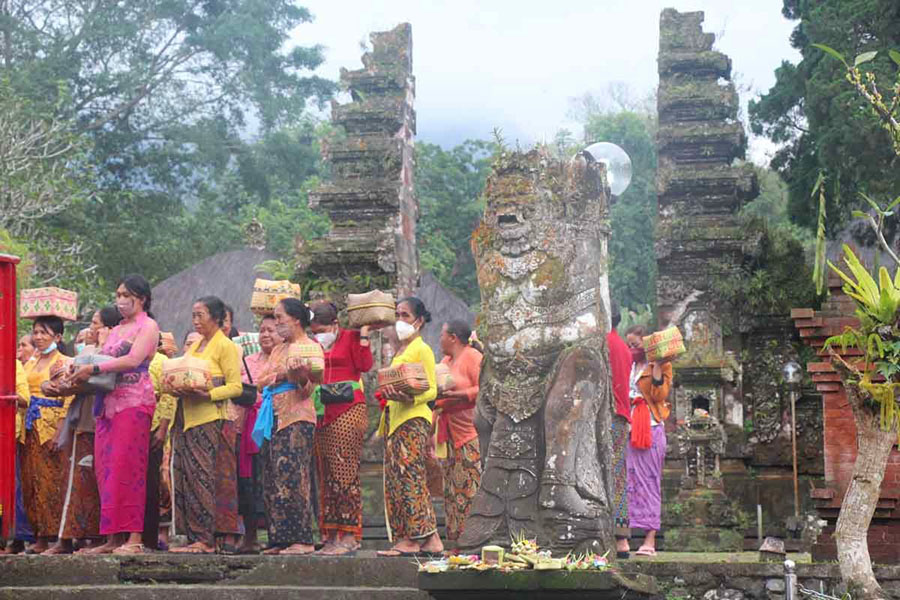BALI BATUKARU TEMPLE
BALI BATUKARU TEMPLE IS BALINESE HINDU TEMPLE LOCATED IN THE FOOT OF MOUNT BATUKARU

Batukaru Temple is one of the largest Hindu temples in Bali (Sad Kahyangan), with the status of Catur Lokapala Temple and Padmabhuwana Temple. Located in Tabanan village, close to the Jatiluwih rice terrace, this temple is located in a highland area surrounded by lush tropical rainforest. The place is quiet and far from residential areas, making it suitable for worship. There are several temple buildings scattered amongst the peaceful rainforest, with the majestic Mount Batukaru in the background. The temple is highly revered by the local community and is one of the oldest temples on the island. It is located on the unspoiled slopes of Mount Batu Karu with cool air, attracting travelers looking for a natural and tranquil atmosphere.
If you visit Batu Karu Temple, here’s what you need to know :
- Location Batukaru Temple
- Meaning of the name Batukaru
- History Batukaru Temple
- Batukaru Temple Restoration
- Unique Batukaru Temple
- Batukaru Temple on Festival
- Tri Mandala Concept at Batukaru Temple
- Dress Code Batukaru Temple
- Batukaru Temple Facilities
Location Batukaru Temple
Luhur Watukaru, also known as Batukaru Temple, is located in Wangaya Gede village, Penebel sub-district, Tabanan regency, in the western part of Bali. The temple is located right at the foot of Mount Batukaru and is about 1 hour and 30 minutes from Denpasar Airport. It is very close to the Jatiluwih Rice Terrace, a famous tourist destination. If you visit Jatiluwih, it is highly recommended that you also visit Batukaru Temple, as the natural beauty and uniqueness of the temple will make your experience even more memorable. We from Bali Driver Hire are ready to take you to enjoy the beauty of Batukaru Temple through the Hire Car and Driver program with comfortable private vehicles and friendly and experienced drivers, ensuring your trip to Batukaru Temple runs smoothly and pleasantly.
Meaning of the name Batukaru
The word “Batukaru” comes from the word “Watukaru”, which consists of two syllables, namely “Watu”, which means “stone” and in religious contexts refers to power or energy sources, and “Karu”, which means “coconut shell”. In literary language, there is the term “Wakukaru”, but in everyday usage, it is referred to as “Batukau” or “Batukaru”. In general, in terms of the form and meaning of the word, “Batukaru” can be interpreted as a protective force or as a covering (penangkeb in Balinese), which is in line with the use of “Tirtha” from Batukaru in the procession of religious ceremonies. According to a source from Kompas, the orientation of Batukaru Temple is to the southeast, while the main worship direction is to the northwest, towards Mount Batu Kau. Information from the temple owner states that Luhur Batukaru has a land area of about 2600 m2, which is included in the temple area. Its boundaries are protected forest to the north and east, forest and village road to the south, and protected forest to the west.
History Batukaru Temple
Until now, there has been no definitive record of who built Batukaru Temple. To uncover its origins, data from various sources, such as inscriptions, chronicles, and stories from local people, is needed. Batukaru Temple is very old, as evidenced by the discovery of ancient artifacts in this location that are thought to date back to the megalithic era, long before the existence of the kingdom. During the kingdom’s existence, the temple was restored and used as a Hindu place of worship. Various facts from the history of Batukaru that we have compiled from various sources can be summarized as follows:
- Based on written data such as Chronicle, the history of Batukaru Temple records that the inscription of Batukaru Temple was founded by Mpu Kuturan during the reign of the Old Balinese King of the Warmadewa Dynasty, King Masula Masuli. The king adhered to the teachings of Shiva Buddha, and it is estimated that the establishment of this temple occurred in the 12th century AD. Batukaru Temple functions as the center of Catur Angga and is one of the Sad Kahyangan Jagat Bali Luhur Batukaru Temples, which is an important part of the support of the island of Bali.
- Many scholars argue that Mpu Kuturan was the one who founded Batukaru Temple during his spiritual journey to Bali to spread religious teachings. Mpu Kuturan is believed to have built Sad Kahyangan Jagat, including Batukaru Temple, with the aim of motivating people to maintain balance. The construction of Batukaru Temple is thought to have occurred around the 11th century BC, along with the establishment of other Sad Kahyangan temples in Bali. Sad Kahyangan Jagat consists of six temples whose function is to guard and protect the island of Bali, as recorded in the Balinese chronicles that mention Goa Lawah Temple, Batukaru Temple, Uluwatu Temple, Pusering Jagat Temple, Lempuyang Temple, and Besakih Temple as part of it. Therefore, Batukaru Temple can be considered one of the temples established when Mpu Kuturan entered Bali to spread the teachings of Hinduism and build shrines as places of worship for God.
- Based on the account in the Buleleng chronicle of 1605 AD, it tells of an incident at Luhur Batukaru where, at that time, Buleleng King Ki Gusti Ngurah Panji Sakti damaged the temple in his attempt to conquer the Tabanan area. However, his efforts were disrupted by thousands of wasps that attacked the king and his troops, so his plan to attack Tabanan had to be canceled. From this event, it can be concluded that Batukaru Temple has existed since the time when the king of Buleleng destroyed the temple in 1605 AD. This means that the temple has been built and used as a place of worship by the local people in Tabanan village since long before that event.
- Based on the discovery of artifacts in the Batukaru Temple area, the types of artifacts are very similar to those found in Goa Gajah Temple. The difference is that the statues in Goa Gajah Temple are in a standing position, while in Batukaru, the statues are sitting cross-legged. It is estimated that the construction of Batukaru Temple began during the same period as Goa Gajah Temple in Gianyar, around the 10th to 11th centuries AD. At that time, the Warmadewa dynasty ruled Bali under King Masula Masuli, who followed Shiva Buddhism.
The history of Batukaru Temple can be concluded from various sources that the construction of this temple occurred in the period of 10-11 AD when Mpu Kuturan came to Bali to spread religious teachings and build the Sad Kahyangan Jagat Temple. Batukaru Temple is included in the Sad Kahyangan Jagat Temple. Most likely, this Sad Kahyangan Temple was built during the Warmadewa dynasty, especially if King Masula Masuli had known the existence of Batukaru Temple. From historical data, the arrival of Mpu Kuturan to Bali was around 10-11 AD, while the Warmadewa dynasty came to power around 12 AD. This raises the possibility that Mpu Kuturan brought religious influence to the Warmadewa dynasty, which then caused the king at that time to be active in religious teachings by renovating and building other holy places. This conclusion is supported by the discovery of similar artifacts at Batukaru Temple and Goa Gajah Temple, suggesting that the construction of Batukaru Temple was around 10-11 AD. However, given the very old age and lack of definitive information regarding the origin of Batukaru Temple, historical chronology and artifact discoveries are key to determining the approximate year of construction. If any information is incorrect or needs to be corrected, please let us know so that we can correct it.
Batukaru Temple Restoration
The restoration of Batukaru Temple was carried out in 1959, when the temple was still in ruins. According to records from the Buleleng chronicles, Batukaru Temple was previously damaged due to a conquest attempt made by the King of Buleleng against the Tabanan area. However, the action was thwarted by an army of wasps that attacked the king and his troops, forcing the king to retreat and undo his intention to attack Tabanan village. Repairs to the temple began to be carried out gradually by the local community. In 1977, the local government provided assistance, and the restoration process continued until Batukaru Temple once again stood in splendor, as you can see when visiting it. The main shrine at Luhur Batukaru Temple is the Meru temple, which shows architectural influences from East Java and India. This temple is dedicated to Lord Mahadeva and is surrounded by Perwara temples. In the northeast and northwest corners are the Pelinggih Padma, Ratu Bagus Panji, and Ratu Puseh Kubayan.
Unique Batukaru Temple
Batukaru Temple, besides being one of the oldest temples on the island of Bali and included in the ranks of sacred temples that are very important for Hindus, also offers a uniqueness that only belongs to it. This very popular tourist destination in Tabanan Regency has some noteworthy features, so when you visit there, you will not feel disappointed.
- Luhur Batukaru Temple is part of Padma Bhuwana Temple, which is also known as the nine temples scattered throughout the island of Bali. This is what makes Batukaru Temple so special. As you enter this temple complex, you will immediately feel a very strong spiritual aura, which is able to provide a deep sense of calmness and comfort to your heart.
- In the most sacred area of Batukaru Temple, you can find many ancient artifacts, such as menhirs and terih kampuh (carved or shaped stones), as well as other artifacts scattered in the front yard of this temple. The age of these artifacts is estimated to date back to the megalithic era, suggesting that Batukaru Temple is one of the oldest temples in existence.
- Located on the slopes of Mount Batu Karu, which is considered sacred by the local community, Batukaru Temple has a very natural atmosphere. The shady trees create cool and fresh air around them, creating an atmosphere like being in an unspoilt forest. This is a unique experience that is hard to find elsewhere; only here can you experience such a strong sense of naturalness, and the surrounding forest is often used for trekking activities.
- To the right of the parking area of Batukaru Temple is a very beautiful holy water, which is a small lake with a water source in the middle. This water is highly valued by the local community for its cleanliness, and according to their stories, this holy water has the power to purify the body and soul before performing prayers at Batukaru Temple.
- Religious ceremonies at Batukaru Temple last only a day, which is different from other Hindu temples in Bali that often have a duration of up to three days. The main ceremony is held between the Balinese holidays of Galungan and Kuningan. This is the biggest celebration for all of Bali except for the north and the so-called Bali Aga villages.
- Batukaru Temple has another uniquely beautiful and mysterious feature, seen in the way the ceremony is conducted. The ceremonies in this temple do not involve Brahmin priests as usual but are performed by local priests called “Pancang”. This is very unique, considering that large ceremonies are usually led by a Brahmin priest.
Batukaru Temple on Festival
During religious ceremonies at Batukaru Temple, thousands of Hindus gather to pray. On these days, Batukaru Temple is closed to the public so that there is no interference in the conduct of ceremonies that are very important to Hindus. Kubayan, who is a holy priest, leads the ceremonies at this temple and has a higher status than other priests there. In the performance of prayers on feast days or certain day ceremonies, there is a special procession that must be followed. Firstly, devotees must perform prayers at Beji Temple, which is located to the east of Batukaru Temple or within the Madya Mandala (center) and Nista Mandala (outer). After praying at Beji Temple, they continue praying at the main temple building located in the center of the temple area. Because they have cleaned their hands and mouths by praying at Beji Temple, there is no need to clean themselves before praying at the main temple. This is the specification of the praying procession in Watukaru Temple.
Tri Mandala Concept at Batukaru Temple
The sacred temples on Bali Island follow the Tri Mandala system for their temple structures, which groups the temple area into three important parts: the outer part (nista mandala), the middle part (madya mandala), and the main part (main mandala). This concept is also applied in Batukaru Temple, where the temple area is also divided into three parts. This Tri Mandala principle has been taught for a long time by Mpu Kuturan, who went on a holy journey to spread Hinduism on the island of Bali. Here is an explanation of the Tri Mandala layout in Batukaru Temple:
- In the Outside Area (Nista Mandala), you will find a very large parking area. On the right, there is a ticket counter with officers ready to serve you. You can buy the entrance ticket at this counter. There are also toilets available for visitors, as well as an information center for tourists. This area is large enough to accommodate many visitors.
- In the center area (Madya Mandala), you will pass through stairs leading to a small gate that is so beautiful and looks very ancient. As you step into the center, you will find a spacious wantilan, used as a resting place and also as a gong holder during religious ceremonies at Batu Karu Temple.
- At the Main Area (Utama Mandala), you will enter through the center area and find a gate that looks very old yet very beautiful. As you step deeper into the temple, you will be greeted with the Batu Karu Temple, which is filled with an alluring spiritual aura, providing a very immersive experience. This area is the most sacred among the other parts.
Having been renovated a few years ago, the concept of the elements and structure of these three areas of the temple are even more timeless and well-organized. Pay particular attention to the outside area, where we can find the Wantilan (Meeting Hall) building that can be used for various events, located to the right of the entrance gate. Improvements in the parking area have also helped the Hindu community and tourists visiting the temple. The large parking area and beautiful scenery create a very religious atmosphere, making a visit to this temple very enjoyable. Visiting Batukaru Temple provides a unique experience compared to other temples. A strong spiritual aura is felt here, supported by the ancient design of the temple and its great age. You can feel the presence of this spiritual aura when visiting Batukaru Temple, which is highly revered by Hindus on the island of Bali.
Dress Code Batukaru Temple
When visiting temples on Bali Island, tourists are expected to dress modestly and respect the worshipping Hindus by not dressing in revealing clothes. At the Batukaru Temple ticket counter, you can rent a kamen and shawl that you can use to follow the dress code in accordance with Hindu traditions when visiting the temple. You don’t have to worry about bringing a sarong from your place, as the rental facility has been provided at the Batukaru ticket counter. When entering the temple area, it is expected that you maintain good manners, considering that Batukaru Temple is one of the sacred temples that is very important for Hindus. In addition to enjoying the adventure of visiting Batukaru Temple, which is rich in history, you can also enjoy the stunning natural beauty of the surroundings. The spiritual experience you get when visiting Batukaru Temple will be an unforgettable moment for you.
Batukaru Temple Facilities
As one of Tabanan places of interest, Batukaru Temple has complete facilities for its visitors. A large parking area ensures you don’t have to worry about finding a parking space when visiting. Clean toilets are available by paying a donation, so you can use the facilities comfortably. There are also small stalls selling food and drinks to cater to thirsty visitors. These facilities are very important in welcoming tourists who come to visit this temple, which has a very old history. Visiting Batukaru Temple provides a beautiful and unique experience, just as Lempuyang Temple and Besakih Temple also play an important role in the history and lives of Hindus in Bali.

